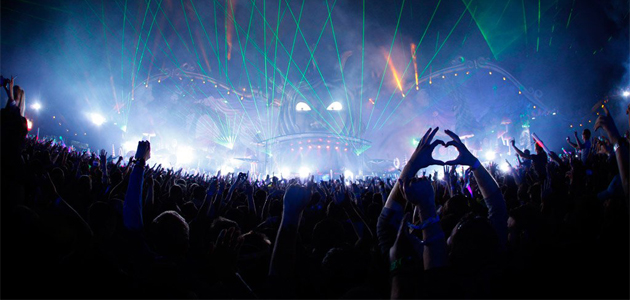How does one make it as a successful DJ?
Of course “success” is subjective, but the American Dream, as the Wu Tang Clan raps, is “…a dream with plans to make C.R.E.A.M.” The acronym stands for Cash Rules Everything Around Me. In America, cash is king, and the world’s most successful DJs are now raking in millions.
According to a recent article in Forbes, “Over the past 12 months, the world’s ten highest-paid DJs pulled in $125 million—more than the payroll of the Los Angeles Lakers.”
This level of income for a DJ was previously unheard of, but electronic Dance Music, or EDM as it is commonly abbreviated, is popular again. This time around, it is bigger than ever. For some, this phenomenon sounds like a fast train to money & fame, and it seems that everyone has a DJ night.
Making it as a successful DJ is the combination of numerous factors including, but not limited to: timing, hard work, talent, consistency, creativity, image, drive and the occasional reality television show. It may seem that people like Joel Zimmerman, aka Deadmau5, or Sonny Moore, aka Skrillex, sprang up overnight, but this couldn’t be further from the truth. Zimmerman’s career began during the first commercial wave of EDM success in the nineties, and Mr. Moore was playing in punk bands by the time he was merely 16.
For those of you out there looking to become the next Skrillex, it is worth clearing up a few misconceptions about the who, the what and the why’s regarding these “Electronic Cash Kings” (ECK), and the road to making it as a successful DJ.

Misconception #1: DJing other people’s music is how to make it big.
When the step by step instructions on how to beatmatch a pair of records weren’t posted on Youtube, and building a substantial record collection had to be done by laborously digging through thousands of dusty milk crates, there were DJs who could claim to have “made it” by primarily playing other people’s records. This is no longer the case.
While these ECK’s are making millions by DJing POPular EDM, it is worth noting that the most important of the pre-recorded sounds are of their own creation, or at least configuration.
The “rebellious” youth shelling out sixty bucks a ticket to see David Guetta, the DJ responsible for the best selling EDM album “Pop Life”, expect to sing along to songs they know, not celebrate communal escapism while discovering new tracks provided by a DJ looking to “take them on a journey”.
Misconception #2: The music played by these successful DJs is “underground” dance music.
Those who are not familiar with the history of EDM, Forbes included, believe that EDM has surged “… from its underground roots and into mainstream consciousness.” This is a grossly overstated idea.
Clearly thousands of people filling stadiums to worship a grown man wearing a bobbling mouse head and armed with nothing more than a laptop is proof that EDM has come a long way since it’s humble beginnings as a synthesized version of orchestral Disco, but the EDM responsible for the “underground” club scene of the 80’s and 90’s in America is not the music that these superstar DJs are using to line their pockets.
Underground dance music was originally a reaction by the LGBT community against the predominantly heterosexual mainstream rock and roll music of the 70’s, but much like the gender politics that spawned Disco, things change. Not only has this music been made accessible by online record stores, the music has splintered into numerous genres and sub-genres as it has evolved. We have seen the rise of EDM to mainstream status before, but it did not stick. The survival of EDM in it’s second coming is due to a seemingly Darwinian adaptation to the status quo.
In America the most popular music is POP, get it? The masses didn’t throw out their addiction to POP in favor of a now accessible “underground” sound. A small slice of the EDM pie has been moulded, or rather structured, into a format that is more recognizable by the masses, something more POPular.
A contributing writer for PopMatter.com, August Brown, weighs in on two ECK’s writing “Kaskade, in particular, is a telling test case for the integration of EDM into the existing live music infrastructure. Over nine albums, he’s shifted from orthodox house- and trance-inspired tracks into populist anthems rooted in melody, sultry chorus hooks and often performances by female guest vocalists. Other producers like David Guetta have introduced dance sounds and structures into Top 40 pop…”
The fat cat record label executives of yesteryear will attest to the fact that the more POPular the music is, the more money there is to be made; hence the motivation.
These ambitious DJs have pioneered a new sound which has created a rift, and bifurcated the EDM community. There is now popular, or mainstream EDM, and it’s more chic ancestor. Veteran DJs like Jesse Saunders or Francois K have been unwilling to compromise their music in favor of the masses more accepted format. As a result, they are legends, not celebrities. Their bank accounts are proof of that.
So one must DJ a more POPular form of EDM to be in the running for their own private jet. Great, let’s go build a kick ass music collection.

Misconception #3: Making a hit record will fill the coffers.
Many producers who don’t DJ, feel that if they make that one great track then they will sell millions of them and join the ranks of EDM success.
The rise of the internet, creation of the MP3 and fall of the mega record labels trumps this idea before it can be fully formed anymore. DJs like Steve Aoki and Afrojack will undoubtedly attest to spending more time in hotel rooms than their own bedrooms. This is because once you have established yourself as a DJ and a producer, the real money is made on the road, touring. This is especially true nowadays since we are in the middle of the largest EDM festival movement to date.
If you are a shut-in with a big case of stage fright, it is unlikely you will be rubbing shoulders with the big boys anytime soon.
Misconception #4: If you wear a clever mask, you are sure to end up like Daft Punk.
Sticking feathers up your butt does not make you a chicken. No matter how cool, the mask itself is no magical device that will ensure your success as a DJ or a producer. Clearly knowing how to DJ, making great music, and the willingness to tour are prerequisites. However, the mask is a step in the right direction.
There are hundreds of talented DJs who can tear the roof off the club, but still don’t make it big. Jordan Hewitt, a contributing writer for the online EDM resource Magnetic Magazine, posed the question, “What separates the guys who make great music from the guys who are known for making great music?” According to Hewitt, “…one of the simplest factors is also something many producers overlook or under think: creating an image.”
Creating an image takes more than a single prop. Creating and maintaining an image requires the discipline to remain consistent while keeping the big picture in mind.
We live in what designer Bruce Mau calls a “Global Image Economy”, but the image is not limited to aesthetics or the visual in general. It must pervade every aspect of your work as an artist. Your sound, public personae, stage presence, web presence, video style, and even how you conduct an interview must adhere to your vision as an artist.
The Daft Punk twins Guy-Manuel de Homem-Christo and Thomas Bangalter are a perfect example of this. Since the late nineties they have lived in their robot attire, rarely grant interviews and, as Wikipedia points out, “Very few official photos of the duo’s faces exist, including a blurry one found in the Homework liner notes.” In one of these rare interviews, Thomas Bangalter stated, “We did not choose to become robots. There was an accident in our studio. We were working on our sampler, and at exactly 9:09 a.m. on September 9, 1999, it exploded. When we regained consciousness, we discovered that we had become robots.” The pairs’ focus is on generating an fantastic world for their fans that sets them apart from the swell of ambitious electronic music artists.
Once you have digested these common, albeit incomplete, set of misconceptions about what it takes to becoming a successful DJ, you can begin to plan your attack. However, one must understand that taking this information in stride and applying the lessons learned is not a guaranteed seat in the electronic royal court.
The rest of us will take solace in creating and playing music that we know and love, regardless of the potential financial rewards.




